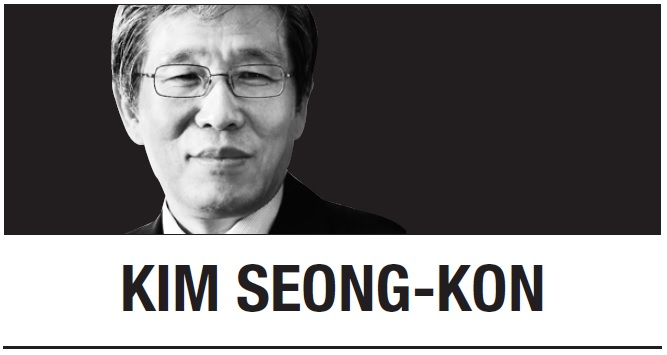
Recently, on the website AsAmNews, I came across an interesting item entitled, “What are the Asian languages most Americans want to learn?” Out of 42 East and South Asian languages, Japanese topped the list, perhaps due to young Americans’ interest in anime and manga. The second most popular language Americans want to learn was Korean, no doubt thanks to the worldwide popularity of K-pop, Korean cinema and K-drama.
That is not all. Amazingly, the same study revealed that Korean ranked sixth on a list of the most popular languages worldwide. Japanese was fifth and Chinese came in ninth. Undoubtedly, the power of Hallyu contributed to this remarkable ranking, as South Korea’s “prominence on the global stage” has kindled foreigners’ interest in Korean.
Of course, South Korea’s remarkable economic success -- what has been called the “Miracle on the Han River” -- its cutting-edge technology represented by Samsung, LG and Hyundai, too, must have prompted “global youth’s interest in leaning the Korean language and traveling to South Korea.” Indeed, school textbooks in foreign countries as far afield as Ukraine carry the story of the Miracle on the Han River. In addition, many young foreigners want to get a job at the aforementioned Korean electronic corporations.
Recently, Laos sponsored an International Korean Speech Contest for Foreigners. At the event, contestants from all over the world competed in their proficiency of the Korean language. Among contestants from 20 countries were Asians, Americans, Africans, and Europeans. All of them impressed the audience with their fluent, impeccable Korean.
The Korean language is by no means easy to learn. According to another website, Korean is one of “the most difficult languages to learn,” alongside Japanese, Chinese and Arabic. However, ardent foreign fans of Korean cultural content learn the language more easily with enthusiasm, while singing along to K-pop songs or watching Korean dramas and movies. It is like young foreigners who learned Japanese while playing video games or watching Japanese anime. Indeed, the power of pop culture makes the impossible possible. So does the power of electronic media these days.
As a result, you can frequently find Korean spoken or written overseas. For example, when you read the manual of an electronic product you purchased, you may sometimes find Korean instructions together with six or seven other languages. If you buy a coffee pack in the US, you can also often find a description of the product in Korean alongside other major languages. When you travel by train in Europe, sometimes you can see information or guides in Korean in the restrooms.
Inside the big American supermarket chain Price Chopper, you can see a big signboard on the wall that says “thank you” in 10 languages, including Korean -- the only Asian language on it. Moreover, when a Korean inserts a Bank of America debit card into an ATM in America, the screen says, “Hi, how are you? What can I do for you today?” in Korean. Watching Netflix movies overseas, you will find that Korean subtitles pop up for many foreign TV drama series and films. Indeed, you can encounter Korean in many unexpected places around the globe. That means today’s Korea is no longer a “hermit kingdom,” but a dynamic, open country.
Many foreign universities have jumped on the bandwagon.
It is now common to see courses offered on Korean TV, cinema and literature, which are quite popular with students. I witnessed it myself at universities in London, Paris and Rome. I also saw it at the University of Prague, the University of Warsaw and Saint Petersburg State University in Russia during my visit to those places. The University of Malaga in Spain, where I was a visiting professor, specialized in Korean Studies, and thus I saw many Spanish students who spoke fluent Korean there.
While I taught in the English Department at the University of California, Irvine, the chairman told me that more than 60 students wanted to sign up for my course on American and Korean films. Sadly, he could admit only 30 students, which was the limit for the course. I also observed that the department of East Asian studies at UC Irvine, too, enjoyed the increasing popularity of Korean literature and film courses. The same thing happened at George Washington University where I also taught. That institution is famous with Koreans because our first president, Syngman Rhee, graduated from it in 1907.
Such a phenomenon is surely encouraging for the Korean people. Four or five decades ago, few foreigners even knew where South Korea was located. At that time, Korea was merely an unknown, underdeveloped country suffering from poverty under a military dictatorship. Today, however, South Korea has become an affluent, fully developed country esteemed by the international community.
It is a great pleasure to encounter Korean overseas these days. It makes South Koreans very proud. South Korea has come a long way, indeed.
Kim Seong-kon
Kim Seong-kon is a professor emeritus of English at Seoul National University and a visiting scholar at Dartmouth College. The views expressed here are the writer’s own. -- Ed.

![[Online Predators] Online reviews of sex tourism in Southeast Asia proliferate](http://res.heraldm.com/phpwas/restmb_idxmake.php?idx=644&simg=/content/image/2024/09/23/20240923050595_0.jpg)

![[Herald Review] 'Culinary Class Wars': fresh, creative survival show minus the drama](http://res.heraldm.com/phpwas/restmb_idxmake.php?idx=644&simg=/content/image/2024/09/23/20240923050497_0.jpg)

![[Exclusive] Democratic Party of Korea forms US election task force](http://res.heraldm.com/phpwas/restmb_idxmake.php?idx=644&simg=/content/image/2024/09/24/20240924050243_0.jpg)
![[Grace Kao] NewJeans fights Hybe for their survival](http://res.heraldm.com/phpwas/restmb_idxmake.php?idx=644&simg=/content/image/2024/09/23/20240923050732_0.jpg)
